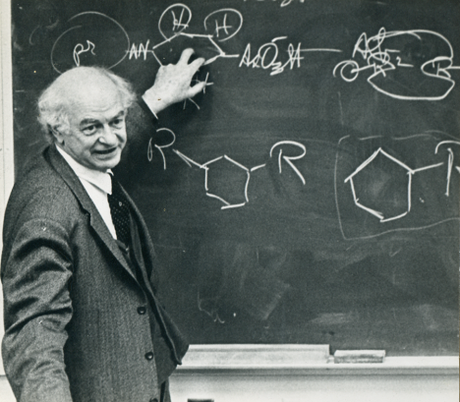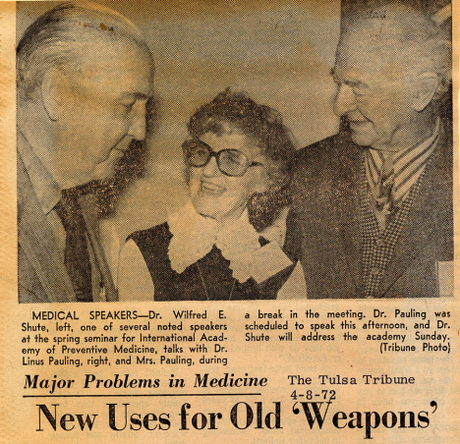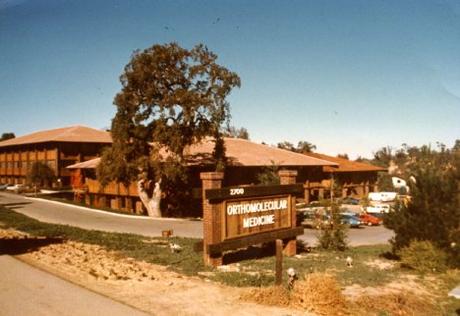
Pauling in lecture at Stanford University, 1969. Photo by George Feigen.
[An examination of Linus Pauling’s tenure at Stanford University. This is part 5 of 7.]
Linus Pauling knew going into his appointment at Stanford University that grants and outside funding would of paramount importance to keeping his research afloat. In September 1972 – three years into his tenure – Pauling authored a memo describing his work for the chemistry department in which he explained that his Stanford salary was now coming exclusively from grants, and that he had no other assigned duties at the university besides heading research. He likewise noted that he was actively working to bringing in new sources of money as well. In particular, he had “negotiated” a sickle-cell anemia contract with NIH earlier in June, estimating that $92,000 would be necessary from the agency.
The previous year, in spring 1971, Pauling applied for a grant from the Department of Health, Education, and Welfare to build a field ionization spectrometer for use in his urine analysis diagnoses. This device had only recently become available, the result of new technological advances in instrument design. In his application, Pauling detailed the potentially profound impact that this piece of equipment would have on his work.
This device would make possible simultaneous quantitative analysis and identification of 500-1000 chemical substances in a human body fluid in a time period of a few minutes and with an expenditure of only a few dollars per sample.
Pauling requested $387,554 for the project. It appears from a later report on his activities that he received the grant.
While Pauling enjoyed a long track record of success in attracting funding for his work, it was not always enough. In August 1972, Perry West, an administrative officer at Stanford, wrote to Pauling’s colleague and lab-mate, Art Robinson, to inform him that the laboratory’s current NIH and NSF funds would only last until the end of the year, two months short of what they had been meant to cover. As it turned out, Pauling’s laboratory had been using more computer time than they had been allocated, and had “drastically overdrawn” one account which they needed reconcile for themselves. The group has also overdrafted a second computing account that West had been funding for them.

In addition to finding money, establishing institutional support for his research was also important for Pauling as he began to push for something a bit more ambitious: the formation at Stanford of a new Department of Orthomolecular Medicine and Nutrition. In a pre-proposal written in August 1972, Pauling called for a revitalization of nutrition as an active field of research at the university. In that same memo he also defined orthomolecular medicine “as the preservation of good health and the treatment of disease by varying concentrations in the human body of substances that are normally present in the body and are required for health.”
A few months later, in January 1973, Pauling brought his proposal to William F. Miller, Stanford’s Vice President and Provost. In making his pitch, Pauling emphasized the potential for orthomolecular medicine to bring in “millions of dollars” of funding. He also described the ways in which interest in orthomolecular research had already been taking off. By way of evidence, Pauling noted several talks that he had given the previous fall, details of which had made their way into the press.
As became readily apparent in the years that followed, Pauling also saw potential for vitamin C to treat a number of maladies including cancer, skin diseases, schizophrenia, the common cold and other infections. To begin actively investigating these tantalizing possibilities, he wanted to establish research centers at both Stanford and the University of Chicago. Miller replied to Pauling that he would consider his proposal and discuss it with the Dean of the Medical School.

The Institute of Orthomolecular Medicine, 2700 Sand Hill Rd. Menlo Park, CA.
During this time, Pauling was also being encouraged by others reaching out to him, particularly Ewan Cameron, a surgeon and medical researcher at the Vale Leven Hospital in Scotland. Cameron shared with Pauling data related to his own successful use of vitamin C in treating bladder cancer patients. Pauling wanted to follow up on Cameron’s success and, in 1972, the two attempted to publish a paper in the Proceedings of the National Academies of Science on ascorbic acid as a treatment for cancer and other diseases. Their paper was initially rejected and, after Pauling resubmitted it, it was rejected again, an action that was described as “professional censorship” in an editorial published within the Medical Tribune.
Undaunted, Pauling continued to push his interests in developing orthomolecular medicine at Stanford and, in May 1973, proposed that the university consider building a new laboratory dedicated to the topic. In addition to the direct benefit of providing support for orthomolecular research, Pauling argued that a new laboratory would remove this work from the chemistry building, allowing it to emphasize its closer sympathies with medical research. Pauling again approached William Miller, telling him that a donor had already promised to give $50,000 for construction, which was estimated to be about half of the total cost. Pauling also expected other grants to come in as well.
Ultimately, Miller did not think it wise to pursue construction of Pauling’s orthomolecular facility. In rendering this judgement, Miller explained that Pauling had only been at Stanford for a short period of time and that his position was subject to annual renewals. This being the case, Miller did not want to “institutionalize” Pauling’s work unless Pauling was able to convince others in the chemistry and medical departments of its importance.
In effect, Pauling was told that, if he wanted his space, he would have to win over his colleagues first and convince them to initiate their own research programs in orthomolecular medicine. If this were to come about and more faculty with plenty of years ahead of them were to push for the idea, then Miller would be more open to considering a new capital project. Short of this, Miller suggested that donor funds be steered toward a more general purpose facility that would be made available to all chemistry faculty members.
Miller’s decision was important as it directly led to Pauling’s departure from Stanford University. Motivated to develop a space to pursue what he believed to be an exciting line of research, Pauling began to look for a laboratory facility off campus. This search led him to a building in Menlo Park near the Stanford Linear Accelerator. Not long after, the building became home to the Institute of Orthomolecular Medicine which, in 1974, was renamed the Linus Pauling Institute of Science and Medicine.
Advertisements